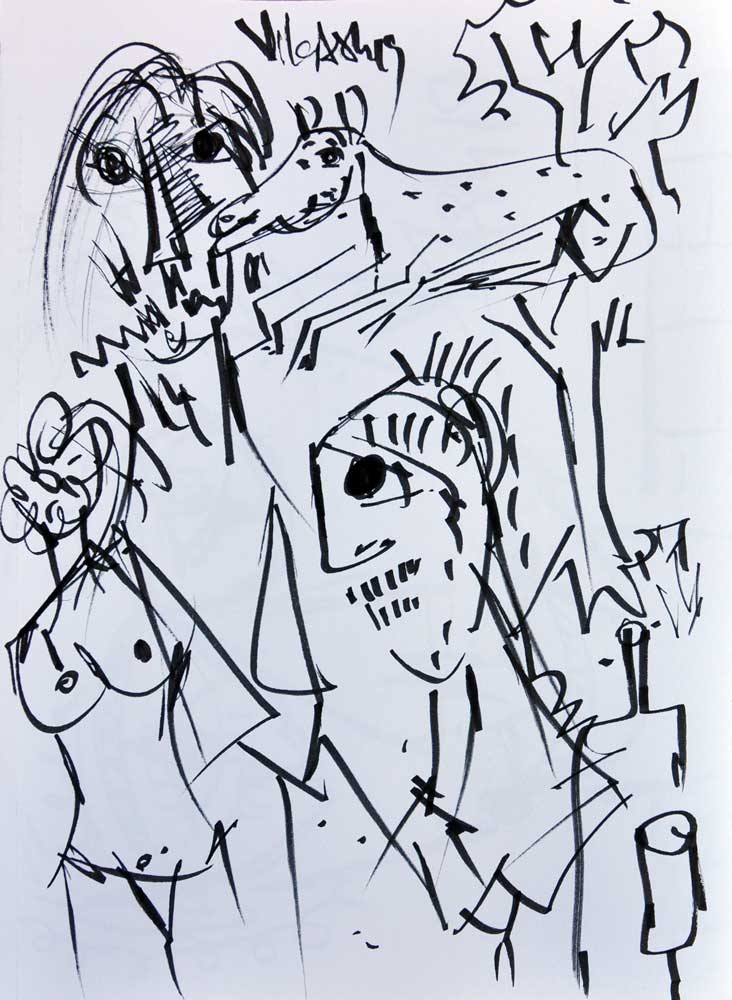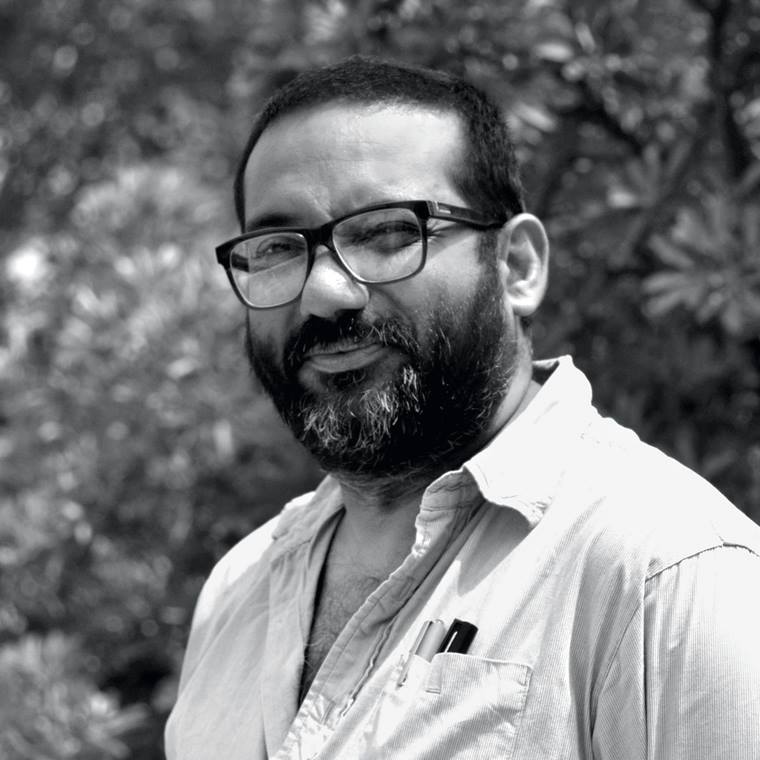From the corner of the Canvas
Vikash Kalra
Drawings 21वीं सदी मे काफी महत्वपूर्ण है, लेकिन इसका उदय 19Th century में होना शुरु हुआ, यह वह समय था जब painters को सम्मानित व्यक्ति माना जाता था और painting बनाना एक healthy mind की निशानी थी l एक subject को देखकर दूसरे subject को बनाना हमेशा past से जोड़ा जाता था तथा जरुरी था कि हम past से जुड़ने के लिए पुरानी drawing को दोहराए l
इस process के चलते, उस समय के कुछ लोगों ने drawings को मरा हुआ समझ लिया, ये लोग खुद को modernization का मार्गदर्शक कहते थे, उनके हिसाब से drawings मर चुकी थी, कुछ नहीं था नया बनाने को, सिर्फ repetition बचा था I लेकिन सिर्फ कुछ लोगों ने drawings के गहराई में उतरने की कोशिश की और जानना चाहा कि आखिर इसका असली importance क्या है I उन्होंने पाया कि इसमें unlimited diversity है जो पहले भी important थी और आज भी हैI
Drawings और paintings एक दूसरे से काफी जुड़ी हुई हैं और इस वजह से जो जो नये artists हैं उन्होने पुरानी drawings से कुछ लेकर उस मे अपना कुछ नया डाल कर एक नया subject बना दिया है । इस मे पुरानी paintings के कुछ impressions मिल जाते है ।
Drawings समय के साथ बदलती गई और cubist artists जैसे Pablo Picasso और Gothic works में हम देख सकते हैं कि drawings को नया रूप मिला और reality अलग ढंग से दिखी I Pablo Picasso और Gothic works में हमें किसी भी तरह का personal interference भी नहीं दिखता हैI
हम यह देखते हैं कि कुछ artists ने personal interference से drawings की dictionary ही बदल कर अपने भाव को अनूठे ढंग से बनया है । For example, Picasso, Souza, MF Hussain, Raza और Vikash Kalra.
मैं खुद को इस योग्य नहीं समझता कि इस का मूल्यांकन करूं, लेकिन जहां तक मुझे लगता है इसी तरह की drawings India के arts schools में पढ़ाई जाती हैंI
Drawings मे experiments के कारण artists को नया freedom मिला है, जिससे paintings के subjects change हो गए हैं, हर artist को एक अलग पहचान मिली है और subject अलग तरिको से mature हुए हैं। यह changes 17th century में अपने starting stage पर थे I Rembrandt की drawings में जो lines का importance था, वह उनके समय के musical notation की तरह था जो अपना एक अलग छाप छोड़ती थी। Drawings में छाप छोड़ना कभी भी neutral होकर नहीं हो सकता और अगर neutrality आ जाती है तो इसका मतलब आपकी drawing मर चुकी हैI Drawings में छाप काफी limited है और इसी वजह से artists ने पहले से मौजूद subjects को अलग ढंग से अपने भावों में draw करने कि शुरुआत की। Drawing practice and repetition पर depend है और यही कारण है कि drawing ने sympathy के साथ खुद को कैलीग्राफी में बदल लियाI
Drawing के इतिहास में बहुत सारे प्रश्न छुपे हुए हैं और उसमें से कईयों का जवाब शायद कभी नहीं मिलेगा, उदाहरण के लिए जो caves arts हैं वो कैसे बनी? वे अद्भुत drawings और paintings जो caves में हज़ारों सालों से मौजूद हैं और ऐसा लगता है उन्हे अपने आप किसी ने बेवजह बना दियाI इन अदभुत चित्रों पर समय अपनी छाप छोड़ने में नाकामयाब हुआ है I प्रश्न उठता है कि- क्या जो जानवरों की drawings उन दीवारों पर बनी हैं वो practice की हुई हैं या फिर जैसा कि Max Raphael बताते हैं यह पेंटिंग उस समय के लोगों ने बाहरी दुनिया और जानवरों के प्रति sympathy के लिए बनाया है? उस समय के artists ने ख़ुद को limited subjects तक रोके रखा लेकिन उनके चित्र purity और energy के साथ बनाये गये हैंI सवाल यह उठता है कि क्या वह चित्र बनाने वाले के दिमाग़ में पहले से मौजूद थे या फिर किसी tradition को निभाने के लिए उन चित्रों को दिवारों पर बनाया गया है?
Classical Greek के बचे हुए आर्ट्स और अद्भुत drawings, गमलो, प्लेट्स, cups और कटोरों पर पाये जा सकती हैं, लेकिन हमारे पास ऐसी कोई जानकारी नहीं है जिससे पता चले की इतने अद्भुत रूप से और purity के साथ यहाँ drawings कैसे बनायी गईं I हमें ऐसा कोई सबूत नहीं मिलता जिससे पता चल सके की Classical Greek के लोगों ने क्या उपाय लगाया 2-D से 3-D पेंटिंग्स तक के सफ़र में। अफ़सोस हमें 2D से 3D के बीच की कोई पेंटिंग्स नहीं मिलती है, जिससे Greek कला प्रारंभिक drawings से स्वतंत्र दिखती हैI
Drawings की diversity तथा किन-किन तरीक़ों से drawing की कला का प्रयोग किया जा सकता है इन सबका वर्णन हमें “होकुसाई” के नोटबुक्स “The Manga” में देखने को मिलता हैI यह अद्भुत है; आप ऐसी कोई चीज़ western arts में नहीं पाएंगे यह “बालजेक” के नावेल की तरह अपने अंदर पूरी दुनिया को समेट लेने का लक्ष्य बनाती है और सफल भी हो जाती है। आप इसमें मछुवारा, प्रेत, हीरो, लैंडस्केप, स्नो लिपर्ड, ड्रैगन फ़्लाई और लैंडस्केप पर बर्फ़बारी के चित्र पाएंगे। चित्रों की पूरी दुनिया जिसमें चित्र एक पेज से दूसरे पेज पर बिना अपनी patience खोए चलते हैं, आपको इसमे वह diversity मिलेगी जो हमारे contemporary society ने भुला दिया हैI
Drawing is quite famous in the 21st century but it started rising in the arid world of 19th century when the academies drawing became daily exercise, it became the certificate of health and honor. The right adaptation of the leg, drawn from the prototype, was thought very important to connect you with the past- but never with the present or future.
Due to the above theory or I should say “definition”, majority of the newcomers, those self described themselves as the torch bearer of modernity, screamingly declared that drawing was dead, a craft practice, an archaic trace, a repetition of exiled norm. But only few decided to understand and study the wide variety of the drawing and its wide usefulness in the past and present. And its diversity is exceptional.
Due to its close relationship with the paintings, a large sum of the western drawings was standing on the practice, modification of the existing definition and emphasizing the certain qualities of drawings. It evolved with the time. Early European drawings, or later attempts to codify the visible definition, the Gothic works or the drawings by the cubist artists such a Pablo Picasso, had in common that they tried to ignore the visible personal intervention in their works. We can see that the personal intrusion of the expressionists turn into the graphic vocabulary had taken shift as a stylistic representation. I am not very eligible to evaluate this but I assume that similar processes have evolved and practiced in the various schools of miniature paintings in India.

The introduction of the expressive notations in the visual vocabulary of the drawing has altered the concept of the drawing. This transformation was in it primitive stage in the 17th century. The great importance of the line in a drawing by Rembrandt, quite similar to the musical notations by his contemporaries, stamped the work like signature of the particular person. Making a mark in the drawing can never be neutral. If it becomes neutral it means it is already dead. The marks available are very limited, so the expressionist drawings quickly tend towards the repetition to form a stylistic language, the factor rejected by the protagonists of expressionism. Drawing was based on repetition, or on practice. It shifted from its congeniality to printing and became calligraphy.
There exist huge historical unfulfilled gaps in this brief summary. And many of them can never be filled. For instance, how was cave art created in the Paleolithic age? This exceptional imagery, drawing as much ad painting are made from a long period of time, appears to emerge from nothing. In this marvelous art the term early or late get diminish. Were the wonderful line of the drawing of legs of the animals were tried out or rehearsed? Or are they the outcome of empathy with the animals or the world depicted, as was one suggested by Max Raphael? The artist of that era were confined themselves with fairly limited range of subject matter made with very high accuracy and vigor, the question arise, were the images permanently present in the mind of those artists, so as to bypass the traditions?
In the classical Greek survived art, drawings can be found in the splendid images on the vases- plates, cups, bowls and etc. Line is carried to the very summit of inventiveness as oppose to the tonal drawings. There is nothing to tell us about how a profile of satyr or the multiple linear fold of the garments has been finalized before the being codified, or even we do not know how much practice was required to achieve such refined results. We cannot find any kind of trace whether any forms of drawing were used to achieve the three-dimensional from the concepts of two-dimensional images. The Greek sculptures appear to be independent of the elementary drawings.
One should turn towards the Manga, Hokusai’s set of notebooks, for study drawing’s sheer diversity and the acrobatic manner in which drawings can be used. This is extraordinary; you cannot find this type of thing in the western art. In the manner of Balzac’s novels, it aims to cover the entire world and succeed. You can find figure of fisherman, ghosts, heroes, landscapes under snowfall, snow leopard, dragon flies, and etc. An entire world in which drawing move from page to page, although the drawing’s language never fluctuates, we find a diversity which our contemporary societies have abandoned.
Written by Vikash Kalra
Hindi to English Translate by Abhinath
New Delhi
March 2019

Vikash Kalra is a self-taught artist and writer based in New Delhi whose work has been exhibited across India and is held in several private and corporate collections.